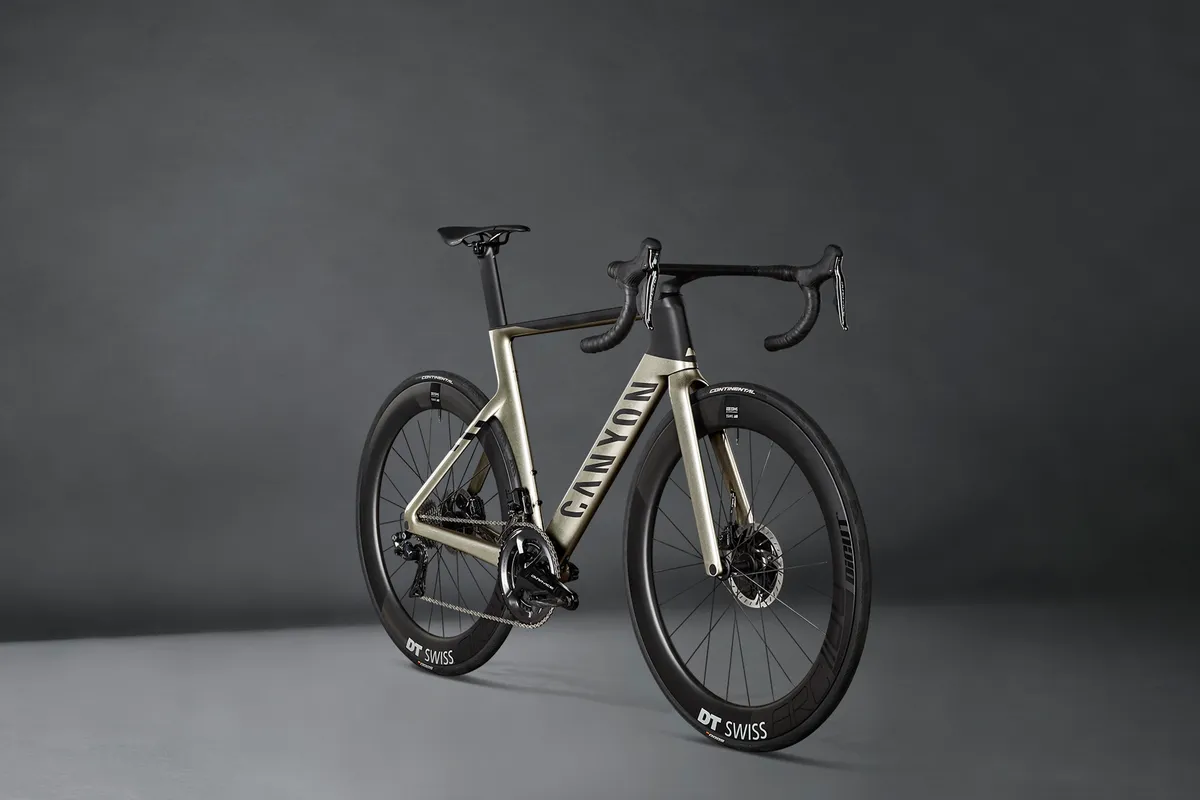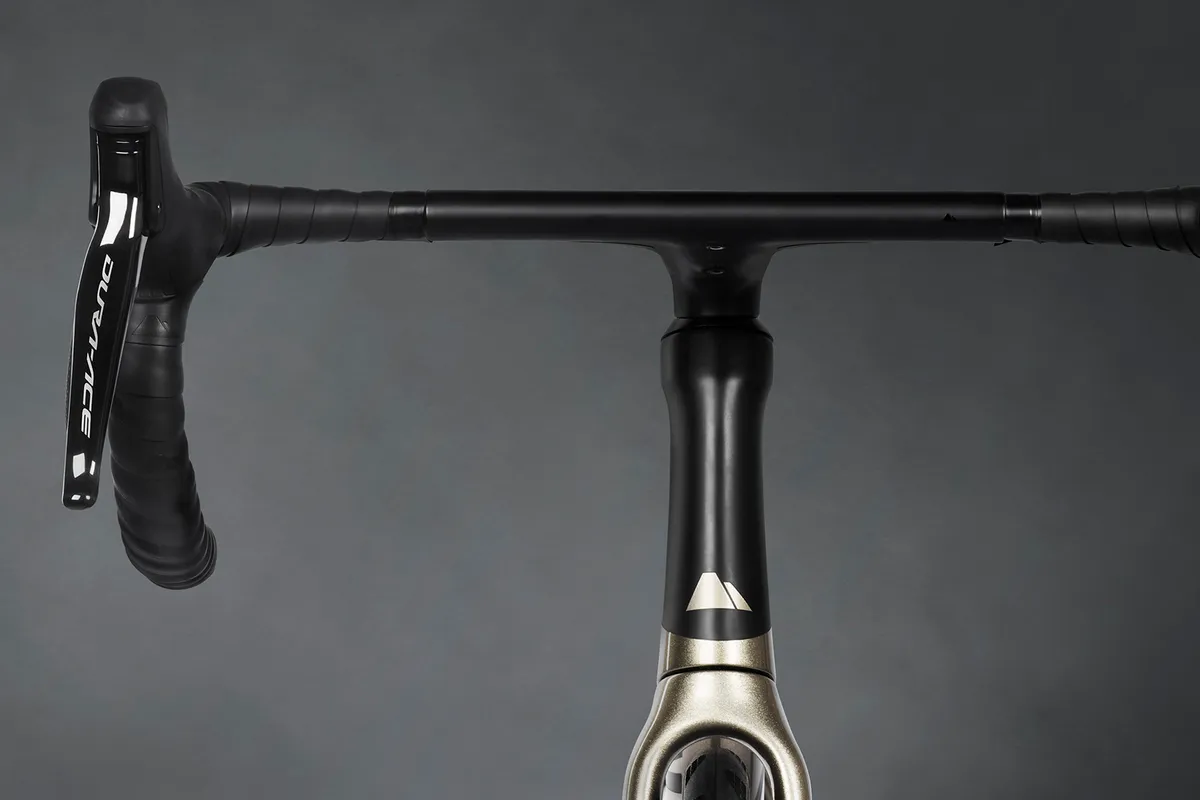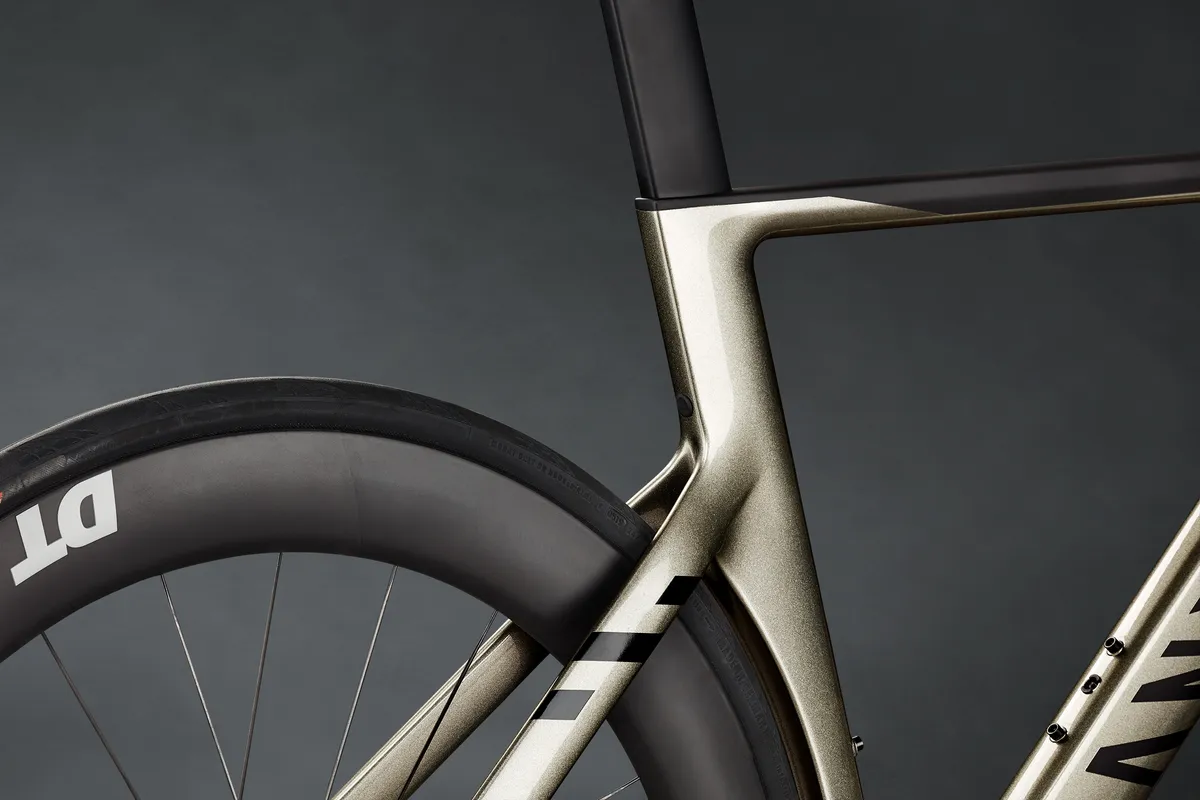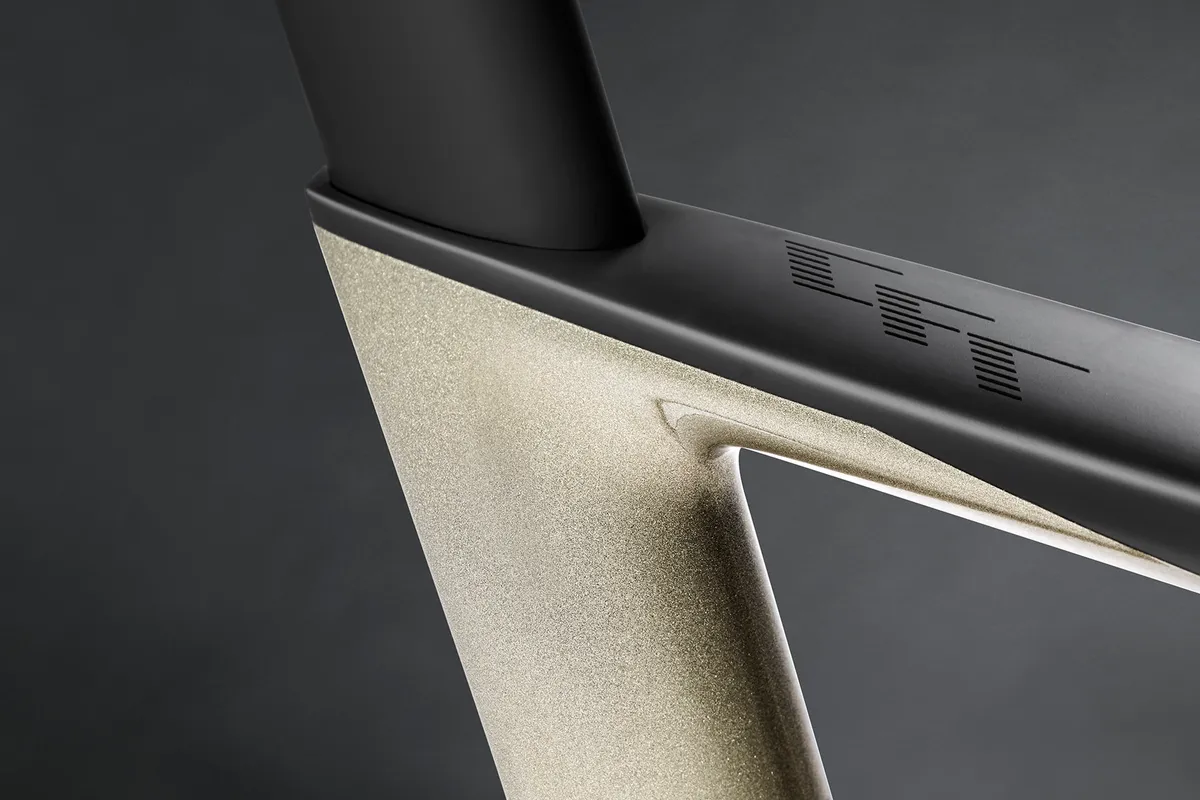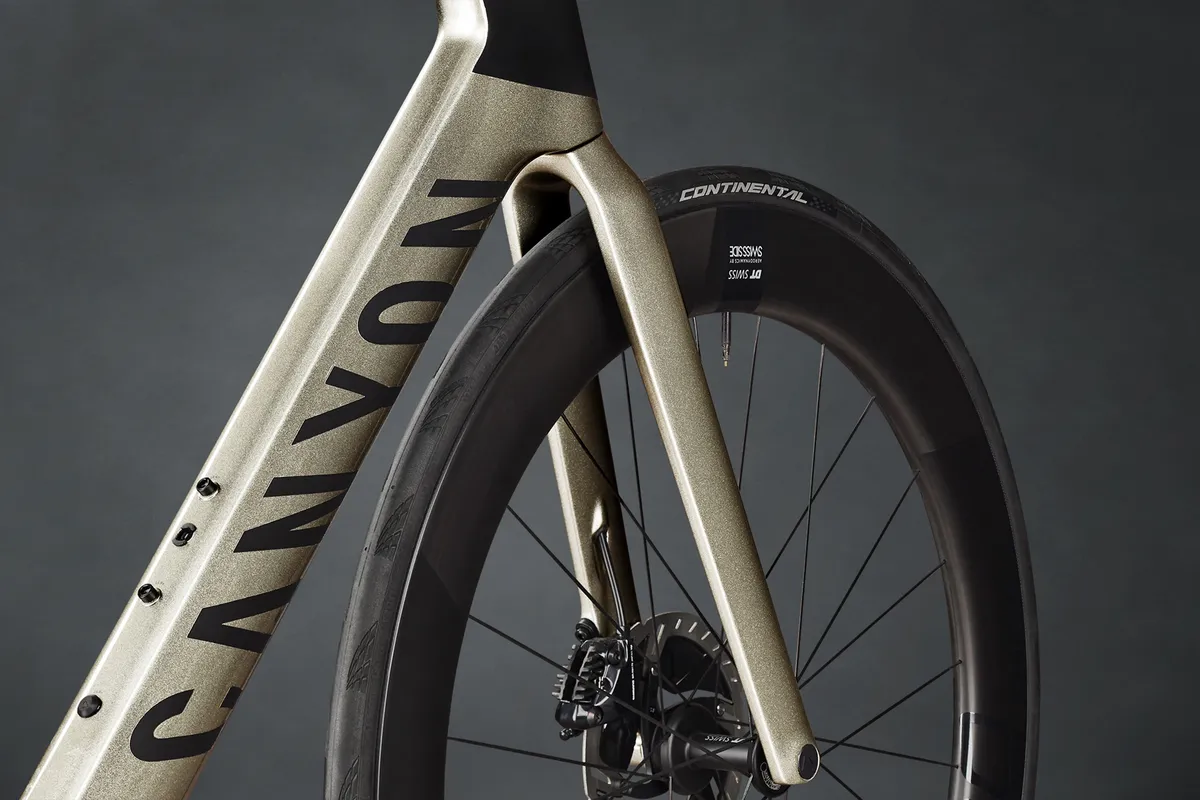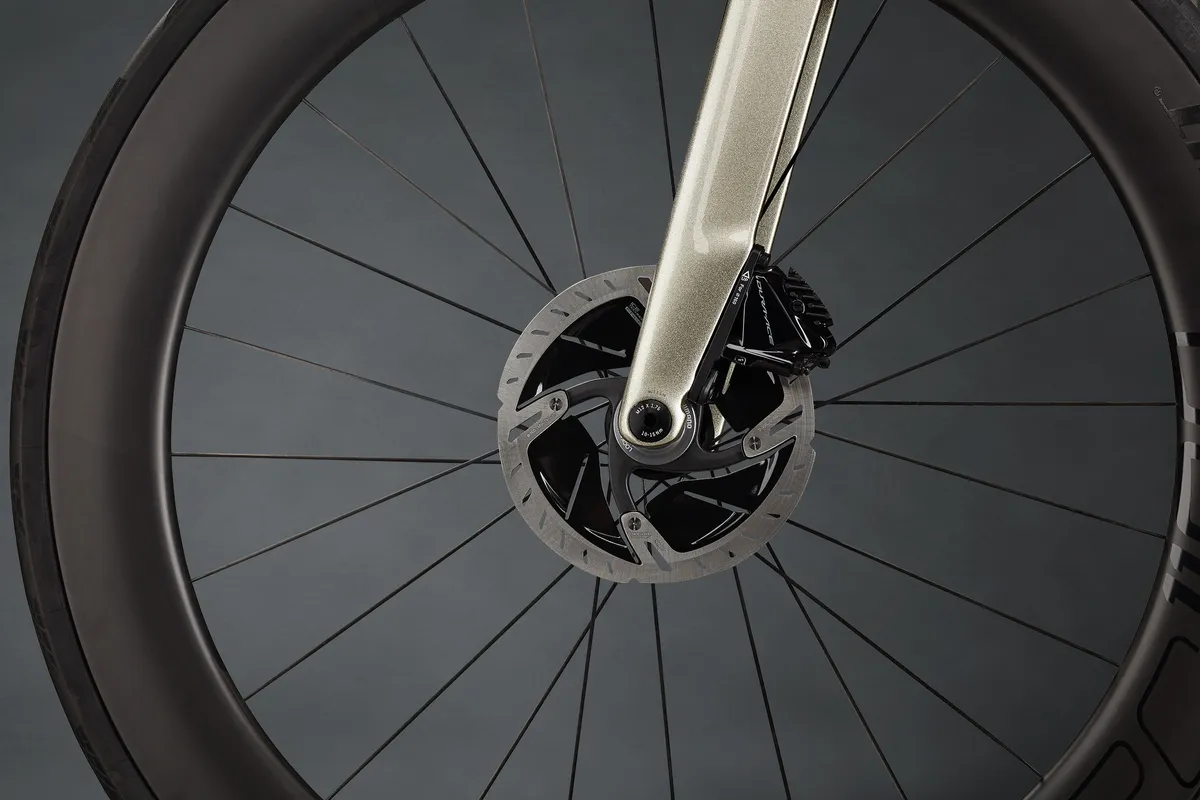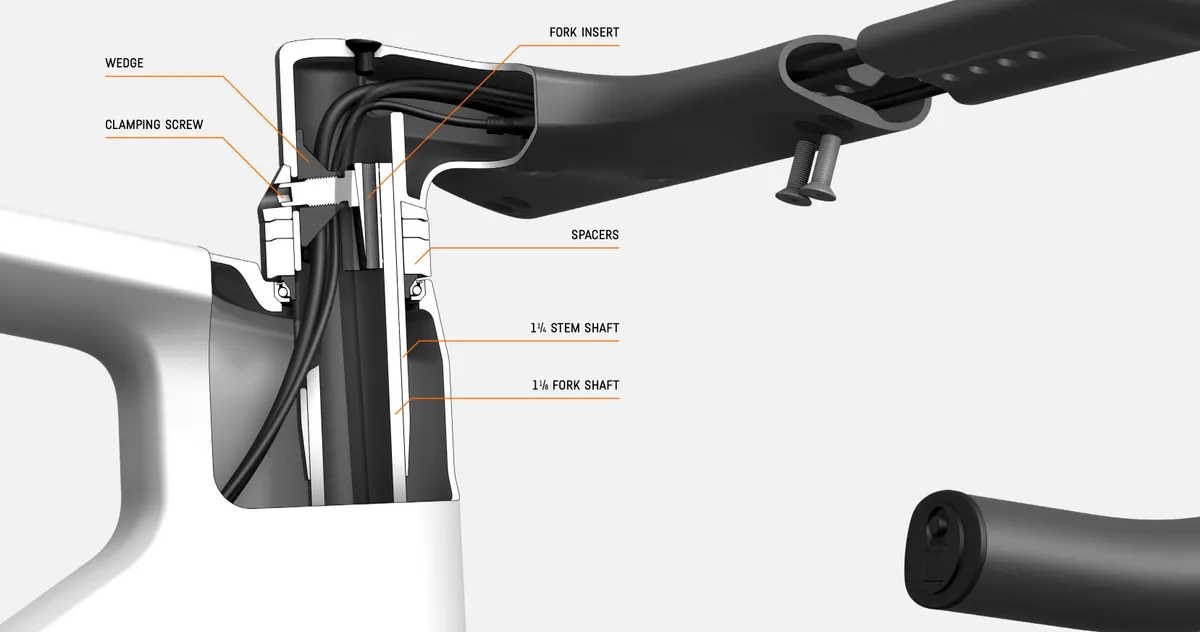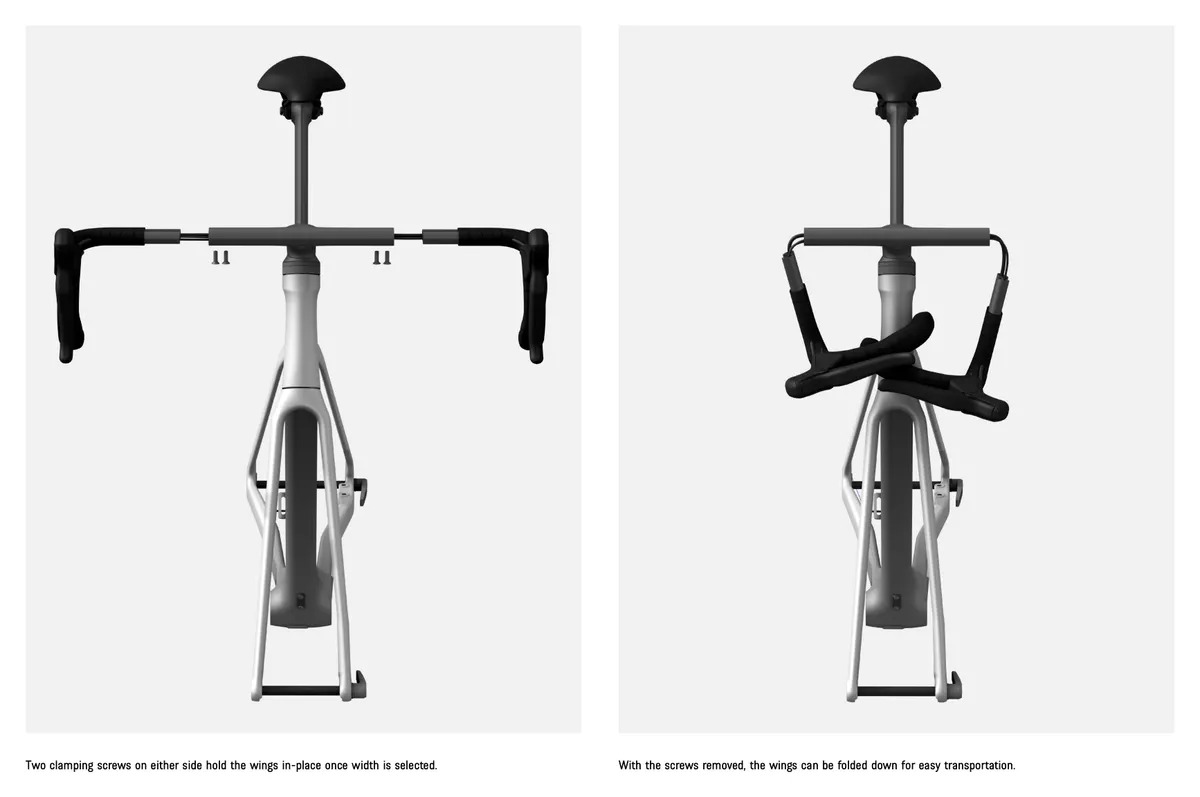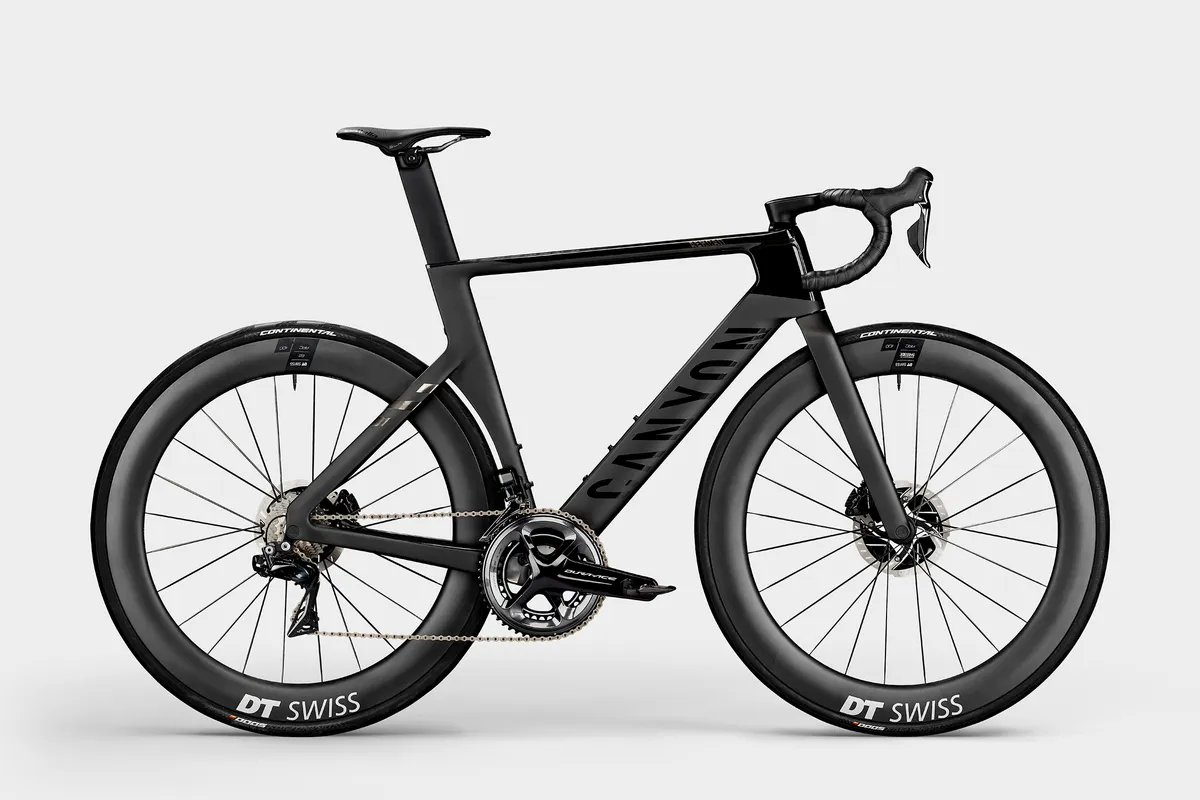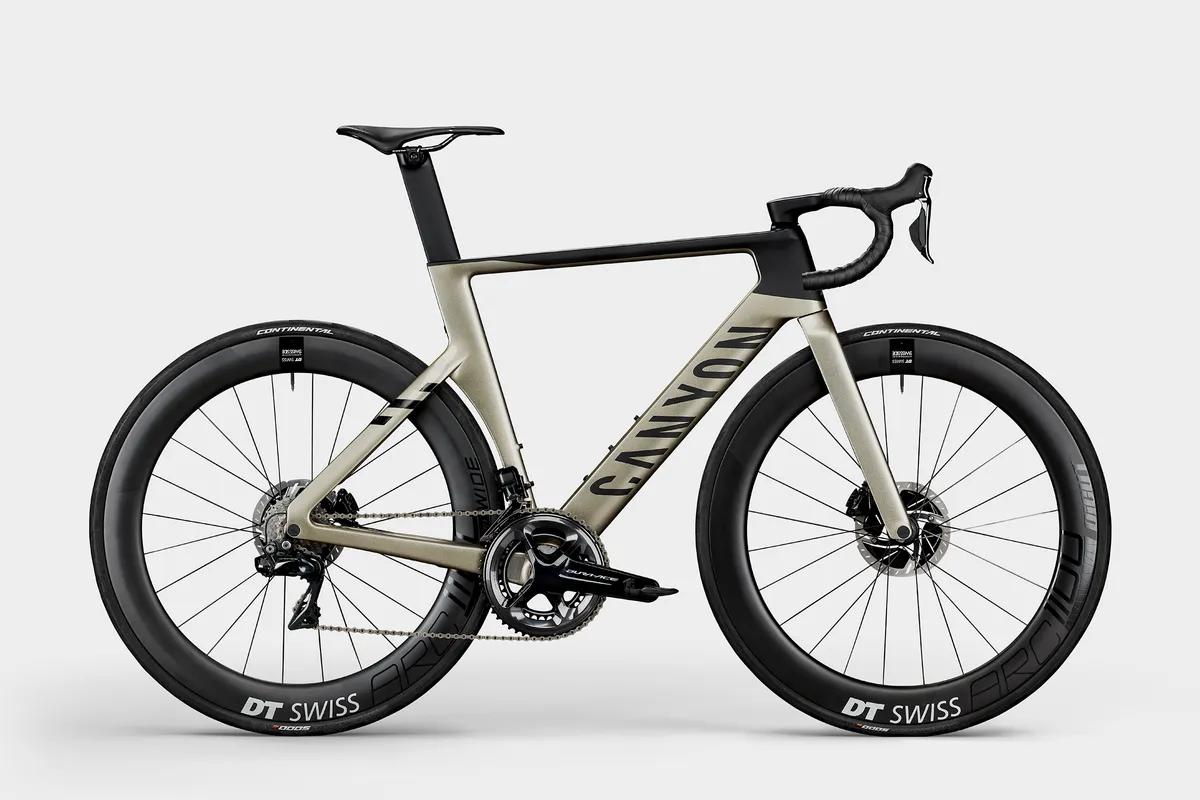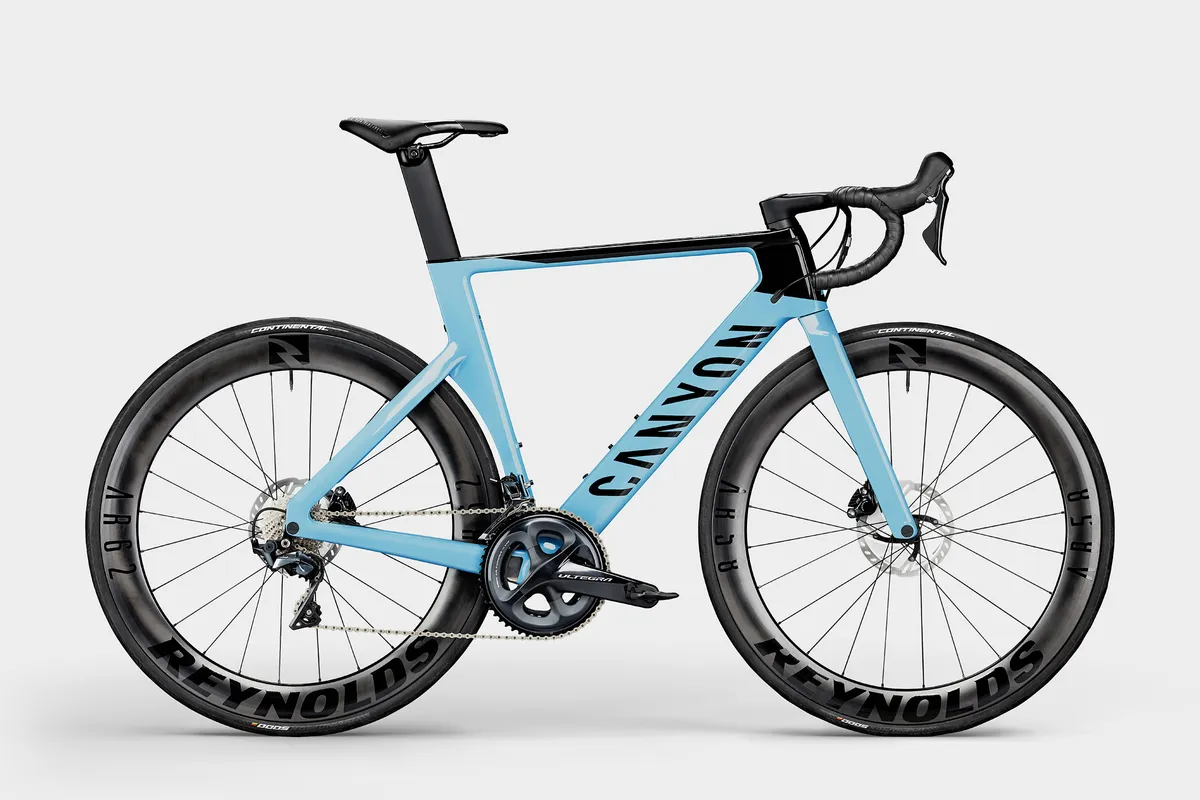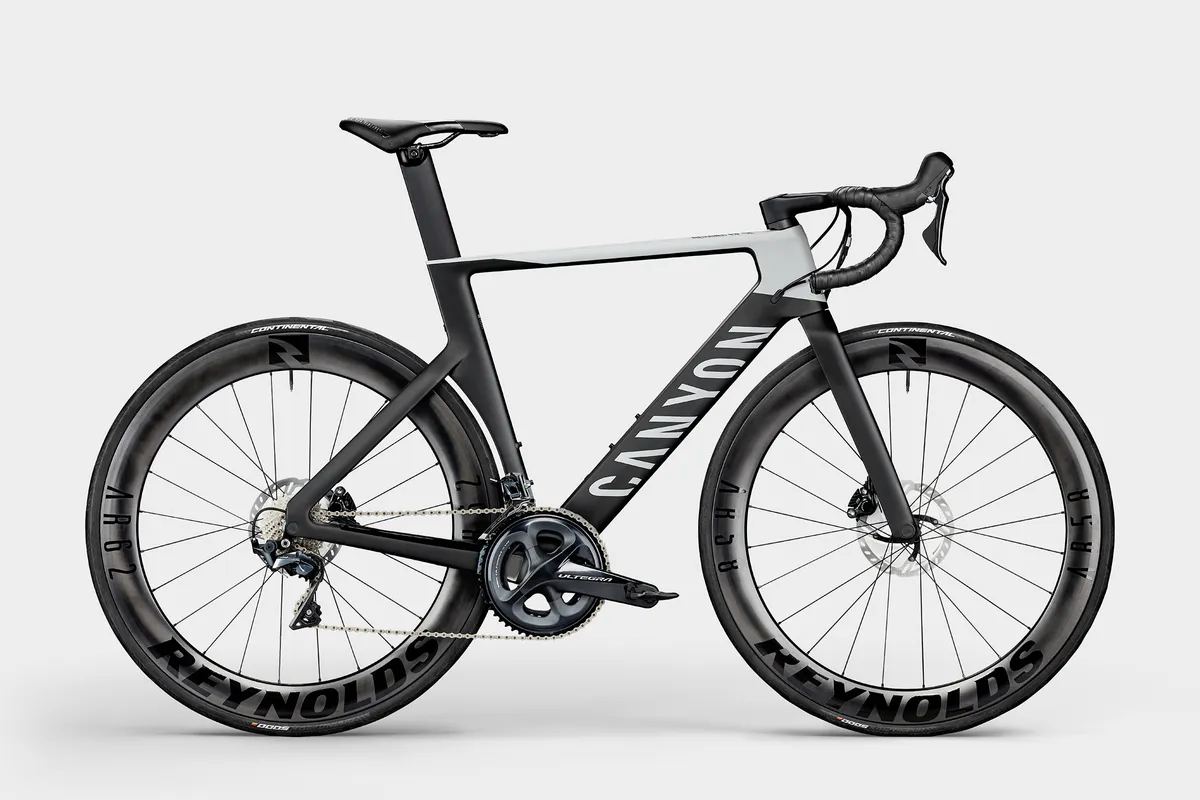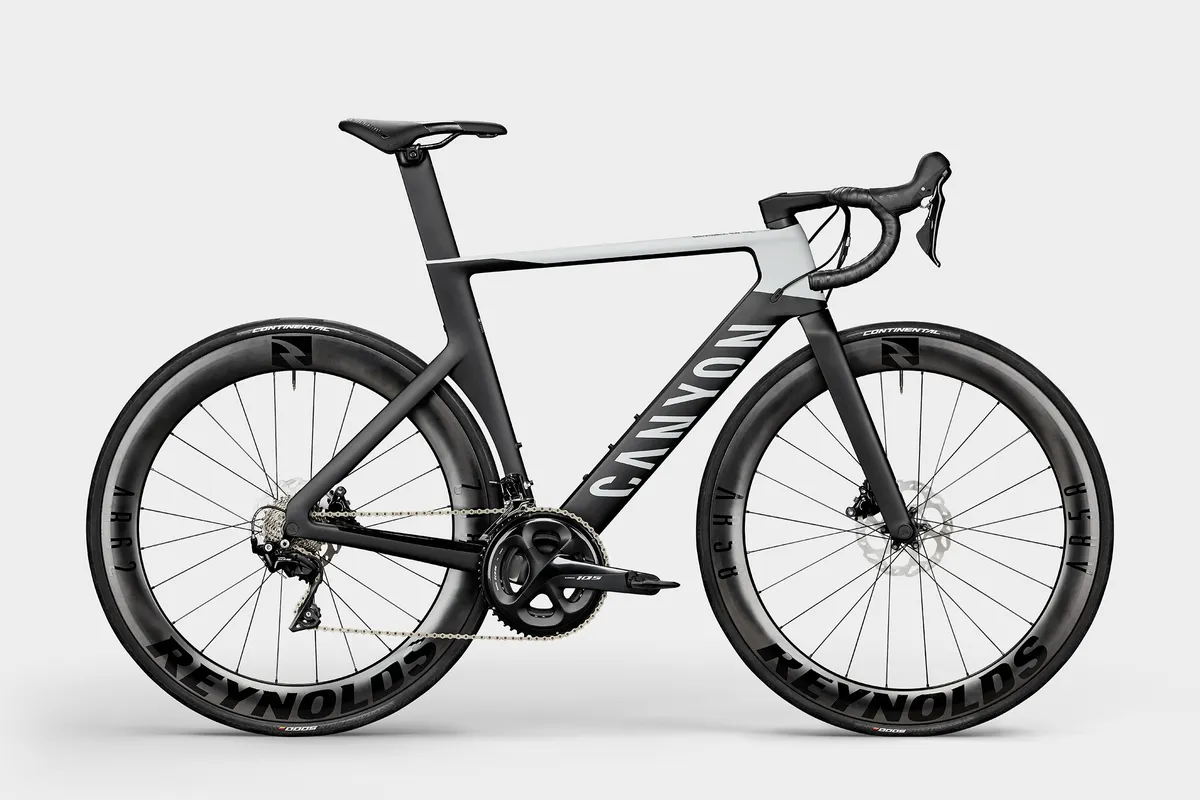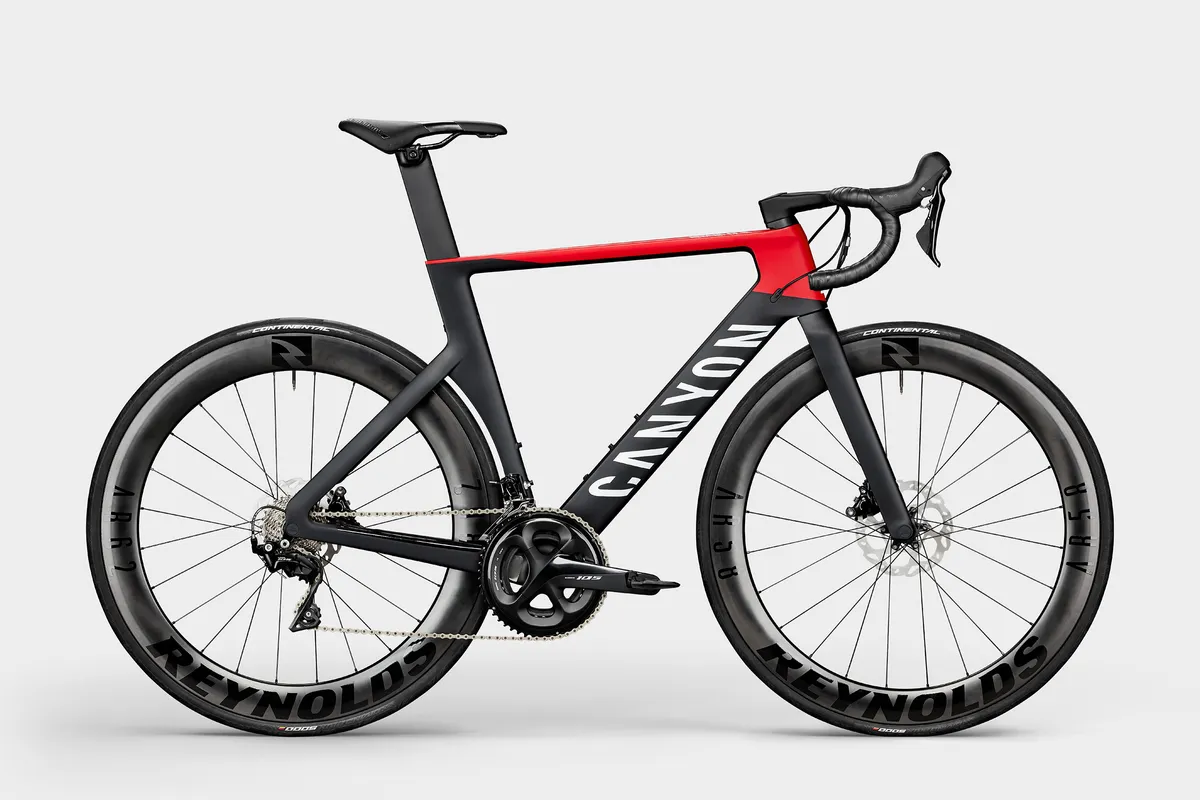After months of teasing in Zwift adverts and at pro races, the new 2021 Canyon Aeroad has finally been officially released.
With more than four years of development behind it, in conjunction with aero experts Swiss Side, Canyon has boldly claimed the new Aeroad to be the "fastest race bike on the market".
Replacing the old Aeroad CF SLX and CF SL models, the new 2021 Aeroad is disc-only and includes a new CFR tier at the top of the range, with CF SLX and CF SL models below it.
In its lightest guise, the Aeroad CFR Di2 is claimed to weigh 7.26kg, but even the cheapest models are said to weigh under 8kg.
Available to purchase on Canyon’s website now, prices start at £3,399 / €3,299 / $3,349 for the most affordable CF SL build and rise to £9,299 / €8,999 / $9,099 for the most expensive CFR build.
For a full breakdown of all the available builds and price points, see our overview at the end of the article.
Want to know how the new Aeroad rides? Check out our full 2021 Canyon Aeroad CFR Di2 review.
2021 Canyon Aeroad | Here’s what you need to know
- Disc-only aero road bike, with new CFR halo range, plus CF SLX and CF SL tiers
- Top-spec CFR model weighs a claimed 7.26kg for a size medium
- Claimed frame weights: CFR 915g, CF SLX 990g, CF SL 996g
- Developed in conjunction with aero experts Swiss Side
- Claimed to be an average of 5.4w more aerodynamically efficient than the old Aeroad at 45kph
- Geometry updated to be slightly less aggressive and match Canyon’s lightweight race bike, the Ultimate
- Integrated cockpit with adjustable handlebar width at CFR and CF SLX levels
- Clearance for 30mm tyres
- A women’s-specific build is available at CF SL level
- Prices from £3,399 / €3,299 / AU$5,149 to £9,299 / €8,999 / AU$14,099
Aero and light enough
While some brands are going down the route of converging their aero and lightweight bikes into one do-it-all package (such as Specialized with its Tarmac SL7), Canyon has focused on making the new Aeroad as aerodynamically efficient as possible. The Ultimate remains Canyon's lightweight platform.
That doesn’t mean it has ignored weight concerns, though. The top-of-the-range CFR models are said to use Canyon’s most advanced carbon fibre manufacturing techniques, to reduce weight and bring the new Aeroad as close to the 6.8kg UCI weight limit as possible.
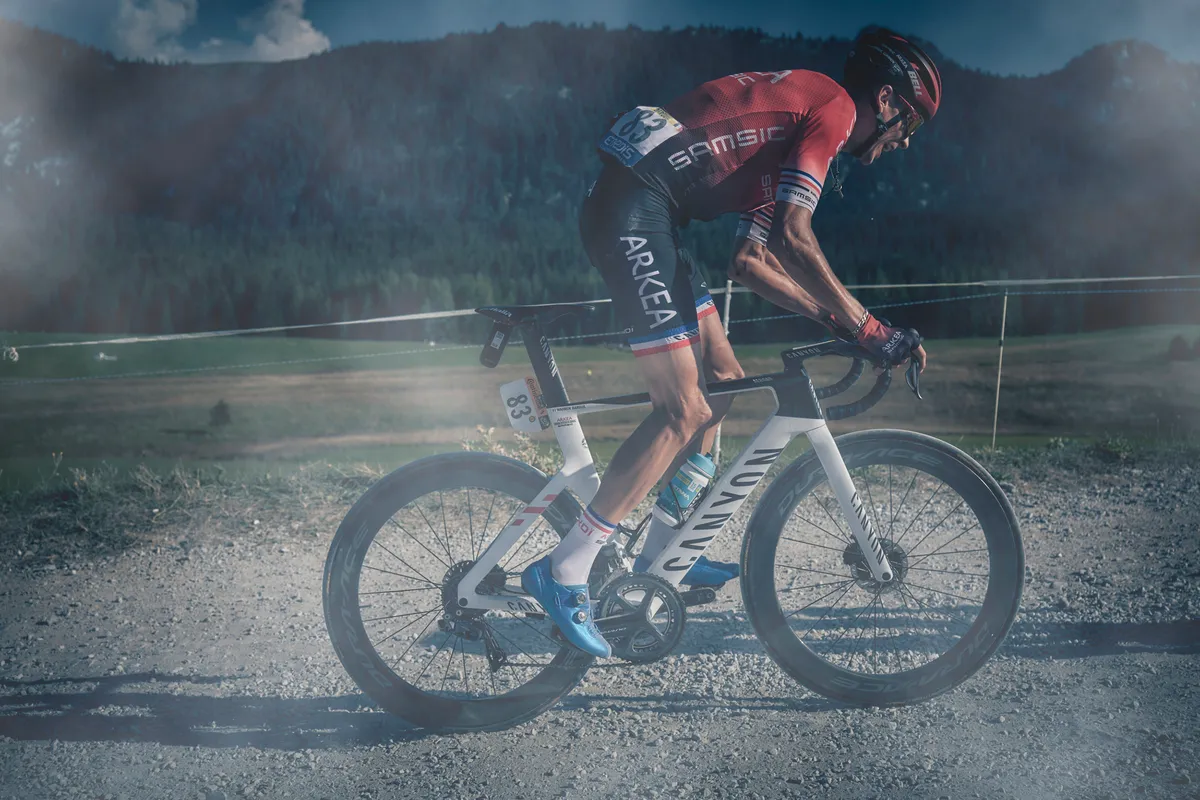
On top of that, increased use of proprietary parts and components means Canyon has been able to reduce the Aeroad's total system weight by optimising those parts solely for the bike, rather than for more general use.
The net effect is that the Aeroad CFR frameset is 168g lighter than the outgoing CF SLX version, according to Canyon. That includes the seatpost, cockpit and small parts such as the seatpost and steerer tube clamps.
The Aeroad CFR frame alone weighs a claimed 915g, according to Canyon, down from 1,010g for the old Aeroad CF SLX.
The new (and now second-tier) CF SLX frame has a claimed frame weight of 990g, while the CF SL comes in at 996g. If that seems like a small jump between the second and third-tier frames, Canyon says that's a result of the reduced hardware required for the CF SLX's fully integrated cockpit.
Specced with 62mm, tubeless-ready carbon wheels, our size medium Aeroad CFR Di2 test bike weighs 7.3kg, with bottle cages and the included GPS computer mount – indicating it would be possible to build it as a sub-7kg aero bike with lighter wheels.
As for the frame, from the outside the changes are quite subtle. The most obvious is that the kammtail aerofoil tube shapes have, across the board, been made wider and deeper than before.
This, Canyon claims, improves the Aeroad’s aerodynamic efficiency across a wide range of yaw angles, and even enables it to harness the ‘sailing effect’ in certain situations where the frameset acts as a sail and the bike is essentially pushed along by the wind.
The Aeroad is specced with Continental GP5000 clincher tyres at every level, with a 25mm tyre on the front and a 28mm tyre on the rear.
According to Canyon, this offers the best compromise of aerodynamics, rolling resistance and comfort. As such, the bike has been specifically designed around this, with the bottom bracket height adjusted to compensate for the larger rear tyre.
Aero development
Let's take a closer look at some of the aero development behind the new Aeroad.
The bike is the result of a long-term collaboration with aero experts Swiss Side. Canyon says it performed over seven times more CFD (computational fluid dynamics) testing for this latest evolution of the Aeroad platform, with each area on the bike apparently assessed and refined to maximise performance.
The simulated tests included a range of yaw angles between +/- 20 degrees and included a rider's legs in both a horizontal and vertical position. Once the fastest frame parts were determined in the CFD software, these were then validated at the GCT wind tunnel in southern Germany – a cycling-specific wind tunnel that Canyon claims is among the most advanced in the world.
Notably, Canyon says the new Aeroad doesn't maximise its aerodynamic efficiency within the current UCI rules. It says it could have made the kammtail aerofoil tubes even deeper in places, but decided against doing so because this would have compromised ride quality and ergonomics.
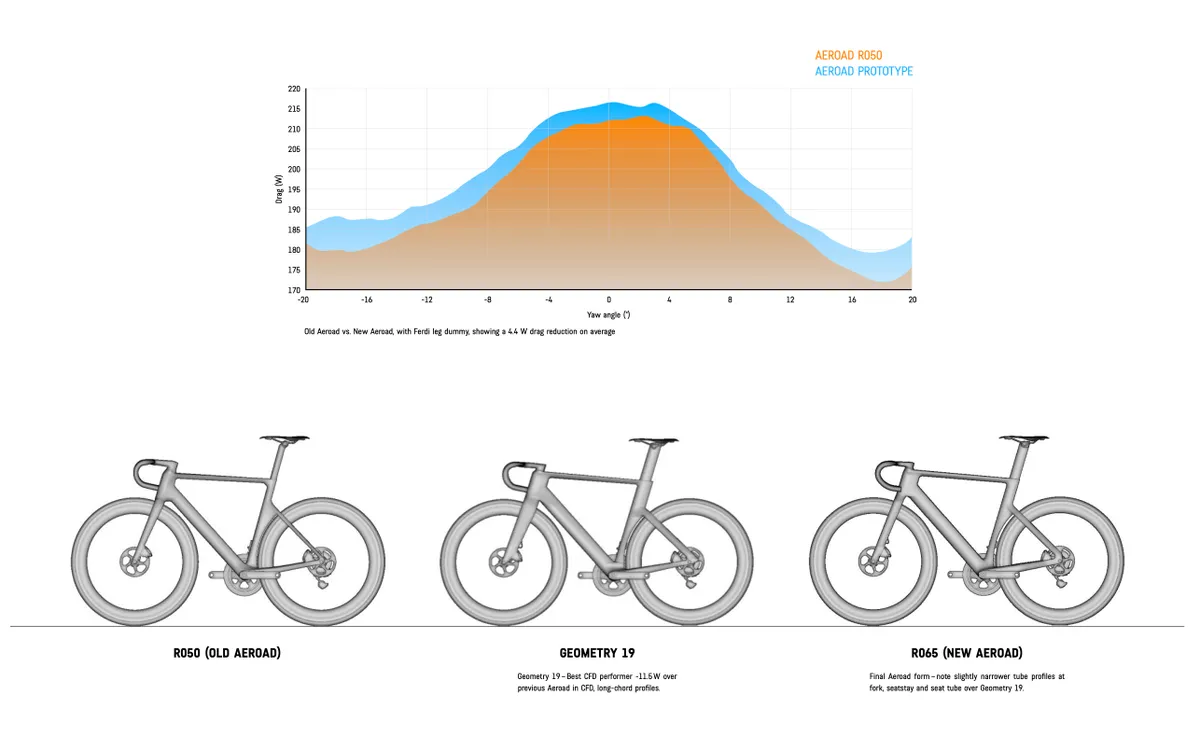
Canyon also tested the new Aeroad in the wind tunnel, both with and without a dummy with spinning legs. As Canyon notes, a rider's legs have a significant impact on the airflow over the bike, so it's crucial to account for this influence during development.
Canyon says a dummy is preferred to a real human being because it provides readings with greater precision and repeatability. Given nothing stock was available on the market, however, it developed its own dummy, dubbed 'Ferdi'.
Overall, the claimed aerodynamic drag saving of the new Aeroad versus the outgoing Aeroad CF SLX is an average of 5.4 watts at 45kph, across a range of yaw angles from -20 to +20 degrees.
That measurement includes Ferdi and two water bottles. Without the water bottles, the saving actually drops to 4.4 watts, but increases to 7.4 watts without Ferdi (though the latter figure is somewhat less relevant for obvious reasons).
Hidden tricks
The bigger changes to the Aeroad are really hidden away from plain sight.
At the rear, the new SP0046 seatpost looks much like any other deep-section aero seatpost. However, in a bid to improve comfort it’s actually a smaller, D-shaped, structural seatpost surrounded by a larger, hollow carbon cover.
According to Canyon, this means it’s both more aerodynamic and more comfortable than the previous Aeroad seatpost, as well as 6g lighter.
The seatpost clamp is positioned further down the back of the seat tube. This allows for a greater amount of unclamped seapost which, theoretically, should mean it can flex more and offer improved comfort.
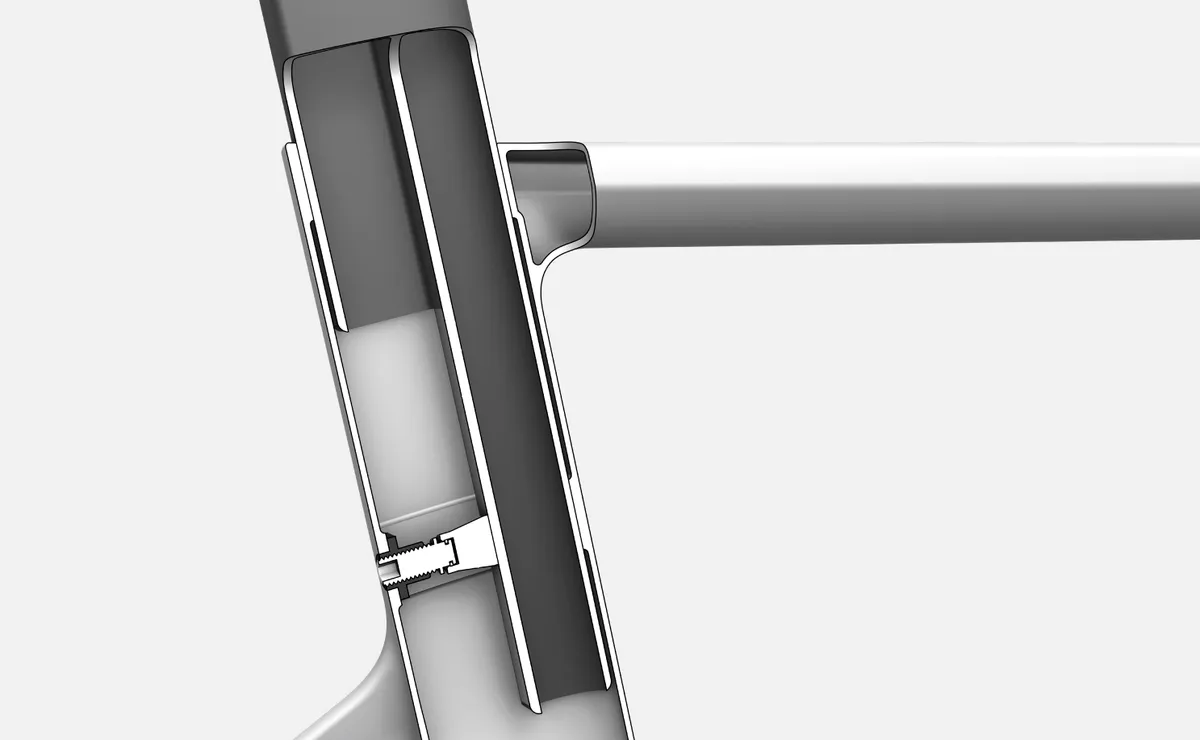
At the front end, the new Aeroad CFR and CF SLX framesets use a proprietary, quill stem-esque system called the CP0018 Aerocockpit.
This fully integrates the gear and brake cables for improved aerodynamics, and offers the ability to adjust the handlebar height up and down by 15mm in 5mm increments, without the need to cut the steerer tube or run spacers above the stem.
It also means you can later raise your handlebars back up, should you wish to.
The wings of the handlebar itself can also be adjusted by 20mm on each side (40mm overall) to cater for both narrow and wide fits. They can also be completely removed without needing to disconnect the gear or brake cables, to enable the bike to be packed for shipping or travel.
Due to space restrictions, this handlebar system is only compatible with electronic drivetrains such as Shimano Di2, Campagnolo EPS or SRAM eTap, though.
The bottom tier Aeroad CF SL builds are built with mechanical groupsets and, as a result, have external cable routing from the handlebar to the frame.
The difference in aero drag between fully internal and external cable routing is said to be “up to 3 watts in extreme cases”, according to Canyon.
Not much, but not nothing either, considering the total claimed improvement versus the outgoing CLF SLX (which had semi-external cable routing) is said to be only 2.4 watts more than that.
CFR vs CF SLX vs CF SL
Instead of trickling bikes out over time, as is often the case with new launches, Canyon has decided to launch three different ranges of the new Aeroad at the same time.
At the top of the pile sits the new CFR range. These get top-of-the-range groupsets from Shimano, SRAM and Campagnolo, with similarly top-spec wheels and components, and are priced accordingly.
Below that are the mid-range CF SLX bikes, which are specced with Shimano Ultegra Di2 and SRAM Force AXS, and slightly cheaper DT Swiss carbon wheels.
At the bottom is the most affordable CF SL range, with mechanical Shimano 105 and Shimano Ultegra groupsets, and Reynolds carbon wheels.
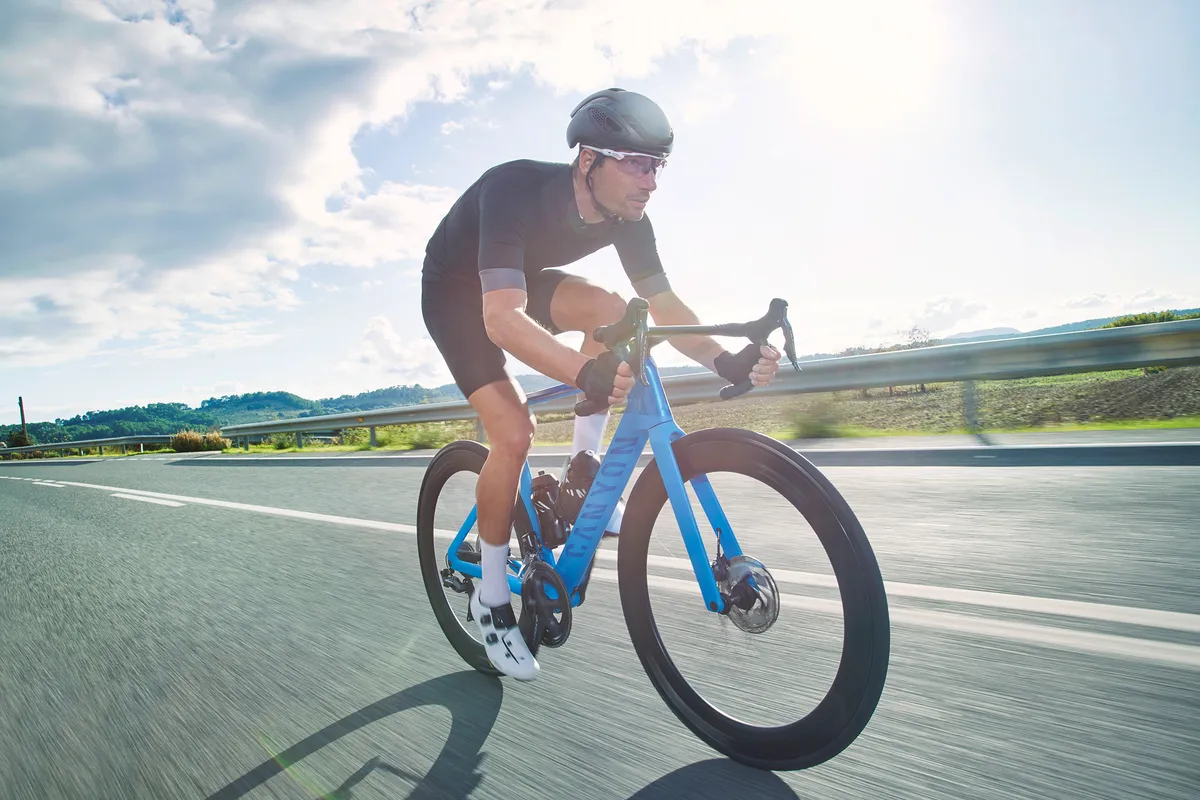
All three ranges use the same tube shapes but have different carbon layups, meaning the CF SLX frame is slightly heavier than the CFR, and has a slightly lower stiffness-to-weight ratio as a result. The CF SL frame is then a bit heavier again.
We’ve added claimed weights for each build to our range overview at the bottom.
The CF SL models also have a standard fork, steerer and handlebar arrangement. This means that, instead of the CP0018 Aerocockpit, the CF SL models come with Canyon’s CP10 Aerocockpit, which uses semi-external cable routing.
The handlebar height can still be adjusted, but, as on most other bikes, you’d need to run spacers above the stem or cut the steerer tube if you want to lower it.
The CP10 cockpit doesn’t have adjustable wings either, so you won’t be able to adjust the handlebar width as on the CF SLX or CFR bikes.
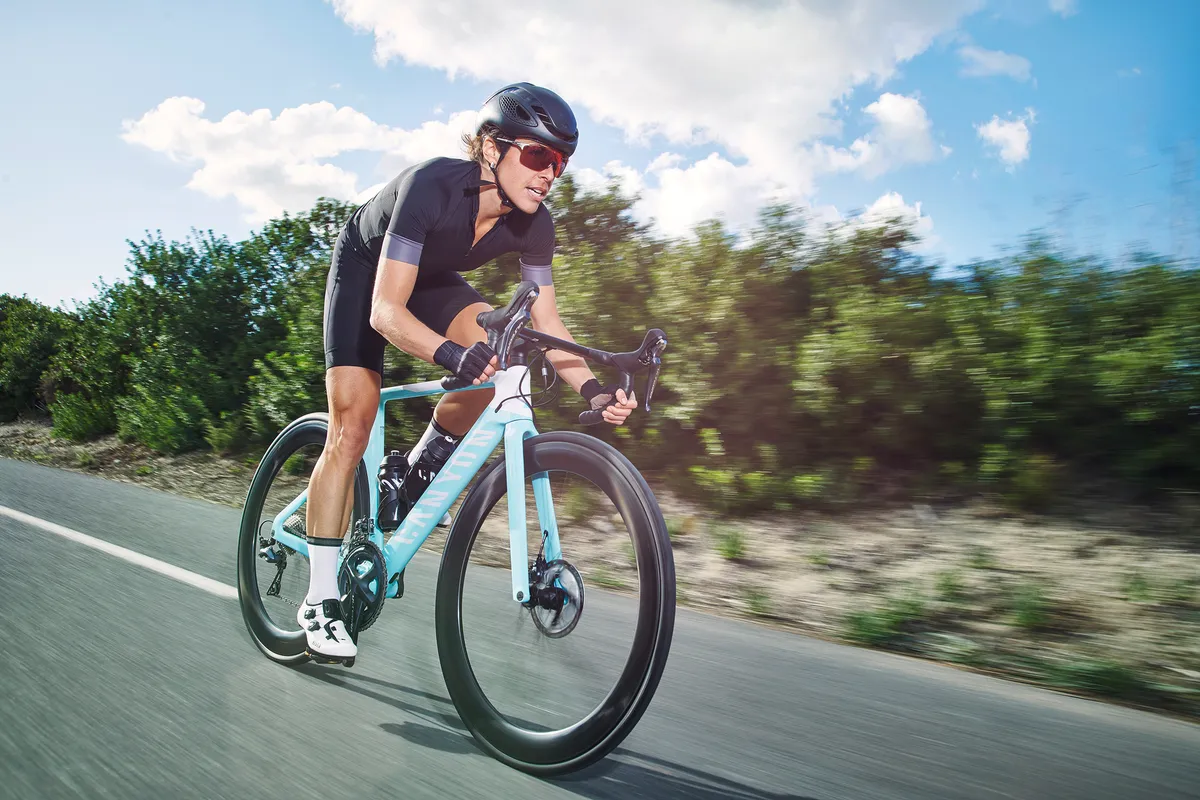
Canyon says it will have a large number of stem length and handlebar width combinations available, though, and that this can be changed at the point of purchase if the stock option isn’t suitable for your fit.
In any case, you could run a standard, non-integrated handlebar and stem with this frameset, if you can’t find the exact combination you need.
The 2021 Aeroad has clearance for up to 30mm tyres and uses a BB86 press-fit bottom bracket across all levels.
2021 Canyon Aeroad geometry
Canyon says the new Aeroad geometry matches the current Ultimate (Canyon’s lightweight, all-round road bike) and that it’s a unisex bike.
There is, however, a women’s-specific build (which comes with a women’s-specific saddle and cockpit) at the CF SL level. All three builds at CF SL level also come in a 3XS size, and 3XS and 2XS builds are specced with 650b wheels.
Aeroad CF SLX and Aeroad CFR bikes start at size 2XS and all models have 700c wheels.
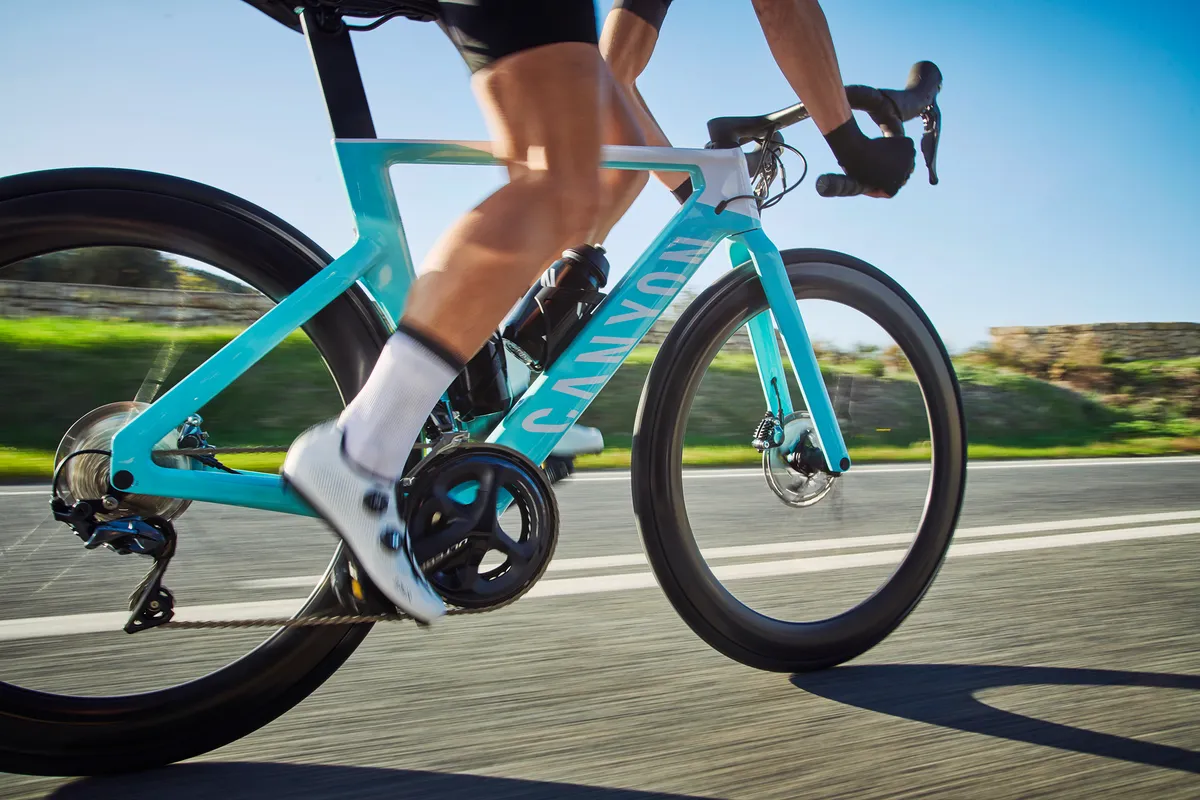
The updated geometry means the new Aeroad is slightly less aggressive, with 9mm higher stack and 5mm shorter reach than the outgoing Aeroad.
Canyon believes this is likely to suit a larger majority of riders, but is also developing a version of the Aerocockpit that will allow for a handlebar position 20mm lower than is possible with the CP0018 Aerocockpit.
This will be a pro-only option at launch, but, in accordance with UCI rules surrounding the commercial availability of equipment, Canyon says it will eventually be made available to consumers as well.
Canyon Aeroad CFR and CF SLX geometry
| Size | 2XS | XS | S | M | L | XL | 2XL | |
|---|---|---|---|---|---|---|---|---|
| Seat tube length (mm) | 443 | 473 | 503 | 533 | 563 | 593 | 623 | |
| Top tube length (mm) | 520 | 533 | 549 | 559 | 572 | 598 | 613 | |
| Head tube length (mm) | 89 | 109 | 126 | 147 | 167 | 193 | 211 | |
| Head tube angle (degrees) | 70.5 | 71.5 | 72.75 | 73.25 | 73.25 | 73.5 | 73.75 | |
| Seat tube angle (degrees) | 73.5 | 73.5 | 73.5 | 73.5 | 73.5 | 73.5 | 73.5 | |
| Chainstay length (mm) | 410 | 410 | 410 | 410 | 410 | 410 | 410 | |
| Wheelbase (mm) | 972 | 977 | 984 | 989 | 1002 | 1025 | 1038 | |
| Stack (mm) | 498 | 521 | 539 | 560 | 580 | 606 | 624 | |
| Reach (mm) | 372 | 378 | 390 | 393 | 401 | 419 | 429 | |
| Stack to reach ratio | 1.34 | 1.38 | 1.38 | 1.42 | 1.45 | 1.45 | 1.45 | |
| Headset spacers (mm) | 15 | 15 | 15 | 15 | 15 | 15 | 15 | |
| Stem length (mm) | 80 | 90 | 90 | 100 | 110 | 110 | 120 | |
| Handlebar width (mm) | 390 | 390 | 390 | 410 | 410 | 410 | 430 | |
| Crank length (mm) | 165 | 170 | 172.5 | 172.5 | 172.5 | 175 | 175 | |
| Seatpost length (mm) | 335 | 335 | 335 | 335 | 335 | 335 | 335 | |
| Wheel size | 700C | 700C | 700C | 700C | 700C | 700C | 700C |
Canyon Aeroad CF SL geometry
| Size | 3XS | 2XS | XS | S | M | L | XL | 2XL |
|---|---|---|---|---|---|---|---|---|
| Seat tube length (mm) | 413 | 443 | 473 | 503 | 533 | 563 | 593 | 623 |
| Top tube length (mm) | 501 | 520 | 533 | 549 | 559 | 572 | 598 | 613 |
| Head tube length (mm) | 103 | 121 | 109 | 126 | 147 | 167 | 193 | 211 |
| Head tube angle (degrees) | 71 | 71.5 | 71.5 | 72.75 | 73.25 | 73.25 | 73.5 | 73.75 |
| Seat tube angle (degrees) | 73.5 | 73.5 | 73.5 | 73.5 | 73.5 | 73.5 | 73.5 | 73.5 |
| Chainstay length (mm) | 405 | 405 | 410 | 410 | 410 | 410 | 410 | 410 |
| Wheelbase (mm) | 951 | 972 | 977 | 984 | 989 | 1002 | 1025 | 1038 |
| Stack (mm) | 483 | 498 | 521 | 539 | 560 | 580 | 606 | 624 |
| Reach (mm) | 358 | 372 | 378 | 390 | 393 | 401 | 419 | 429 |
| Stack to reach ratio | 1.35 | 1.34 | 1.38 | 1.38 | 1.42 | 1.45 | 1.45 | 1.45 |
| Headset spacers (mm) | 27.5 | 27.5 | 27.5 | 27.5 | 27.5 | 27.5 | 27.5 | 27.5 |
| Stem length (mm) | 80 | 80 | 90 | 90 | 100 | 110 | 110 | 120 |
| Handlebar width (mm) | 370 | 370 | 390 | 390 | 410 | 410 | 410 | 410 |
| Crank length (mm) | 165 | 165 | 170 | 172.5 | 172.5 | 172.5 | 175 | 175 |
| Seatpost length (mm) | 335 | 335 | 335 | 335 | 335 | 335 | 335 | 335 |
| Wheel size | 650B | 650B | 700C | 700C | 700C | 700C | 700C | 700C |
But how does it ride?
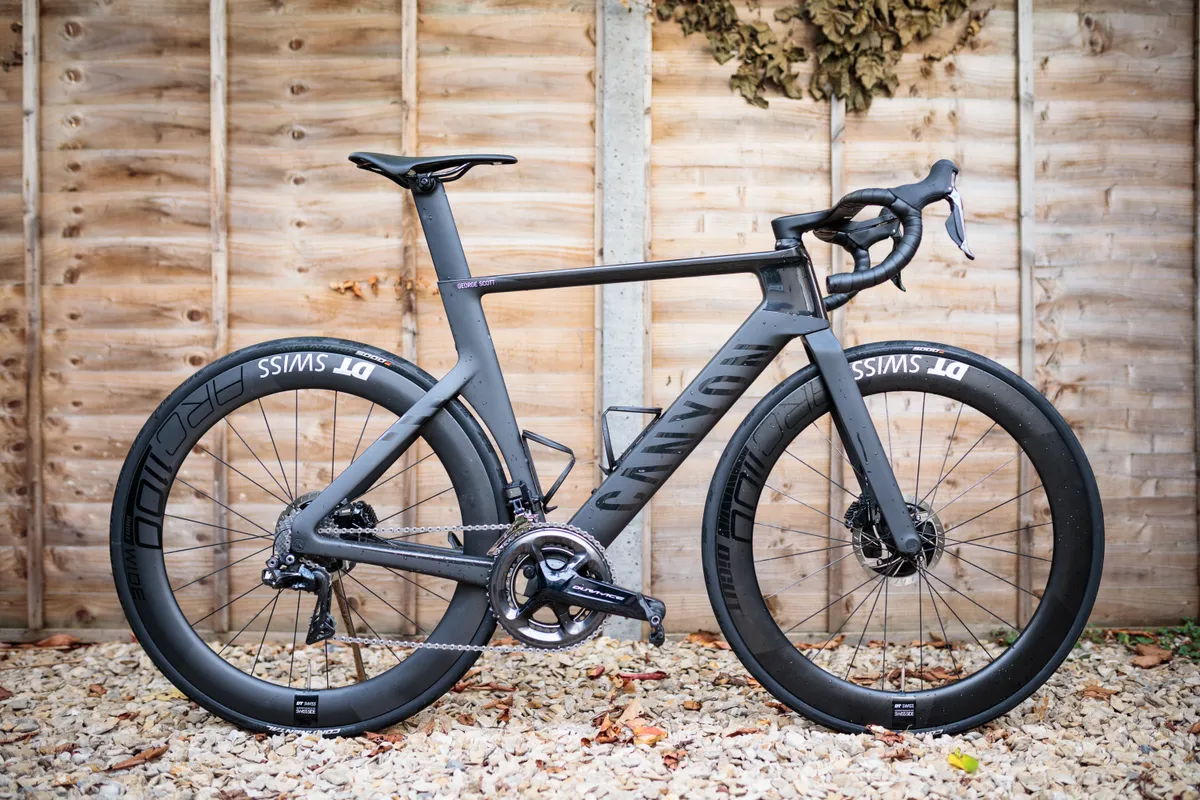
We’ve had our hands on a top-spec Aeroad CFR Di2 for a few weeks now, so for full details on how it actually performs in the real world, don’t forget to check out our in-depth review.
Canyon Aeroad 2021 range, specifications and pricing
Here’s every Aeroad in the new 2021 range, with confirmed pricing and images where we have them.
All of the bikes are available via Canyon’s website immediately, but not every model in the range will be available in the US market at launch (noted below).
Canyon Aeroad CFR EPS
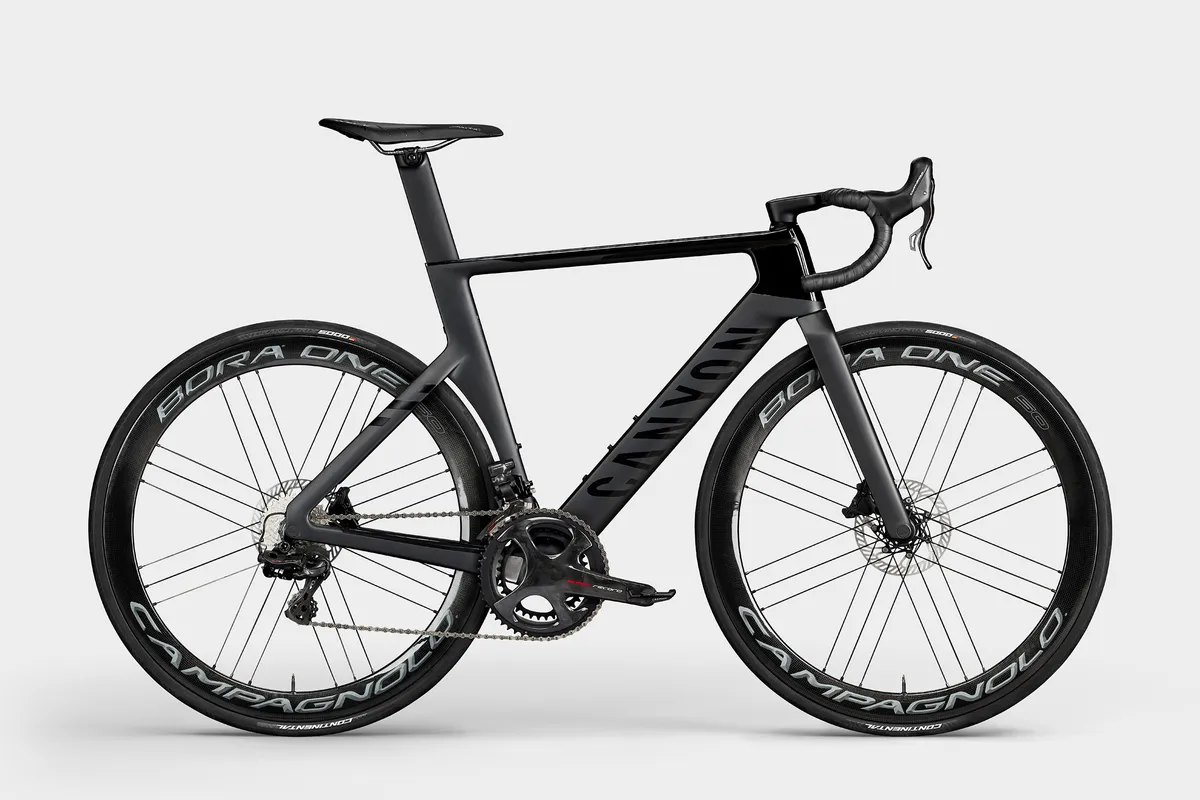
- Frame: Canyon CFR
- Fork: Canyon FK0060
- Handlebar: Canyon CP0018 Aerocockpit
- Groupset: Campagnolo Super Record EPS
- Wheels: Campagnolo Bora One 50
- Colours: Stealth
- Sizes: 2XS, XS, S, M, L, XL, 2XL
- Weight (claimed): 7.32kg
- Price: £9,299 / €8,999 / $9,099 (not available in the US at launch) / AU$14,099
Canyon Aeroad CFR AXS
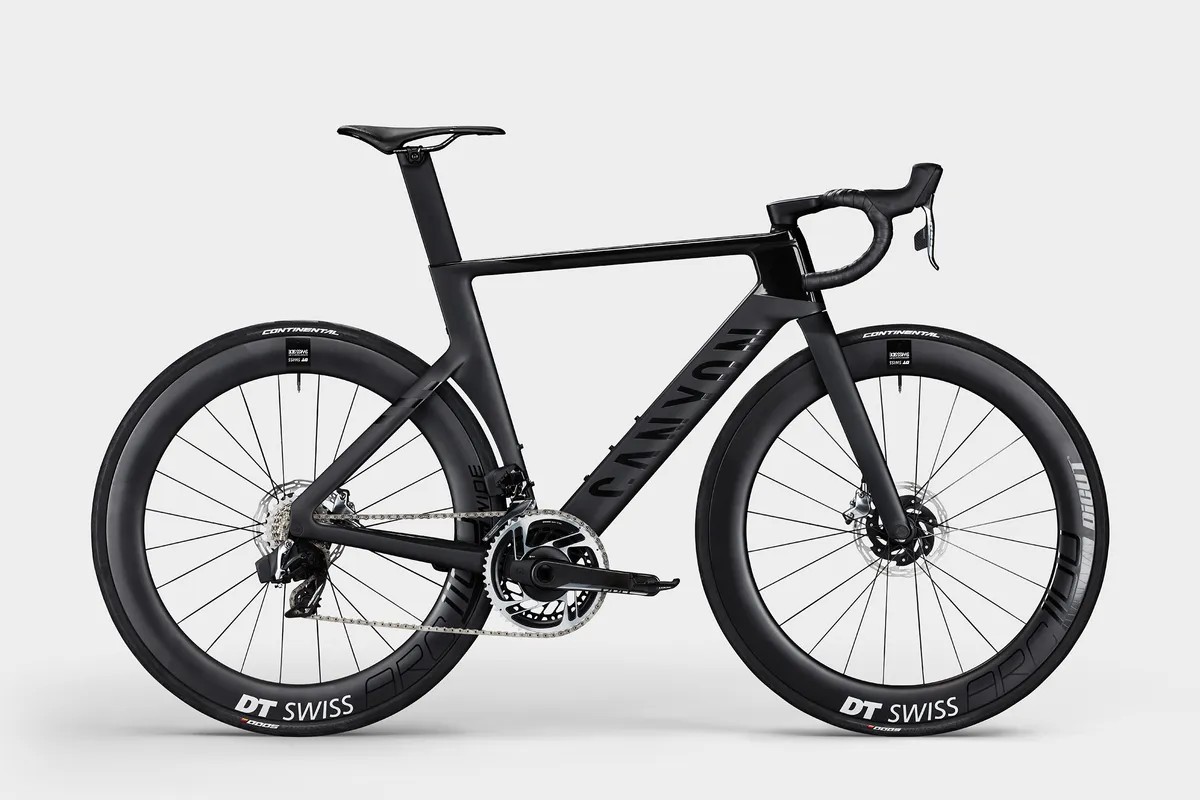
- Frame: Canyon CFR
- Fork: Canyon FK0060
- Handlebar: Canyon CP0018 Aerocockpit
- Groupset: SRAM Red eTap AXS, with SRAM Red AXS power meter
- Wheels: DT Swiss ARC 1100 Dicut 62 DB
- Colours: Stealth
- Sizes: 2XS, XS, S, M, L, XL, 2XL
- Weight (claimed): 7.32kg
- Price: £8,199 / €7,999 / $8,099 / AU$12,549
Canyon Aeroad CFR Di2
- Frame: Canyon CFR
- Fork: Canyon FK0060
- Handlebar: Canyon CP0018 Aerocockpit
- Groupset: Shimano Dura-Ace R9170 Di2, with Shimano FC-R9100-P power meter
- Wheels: DT Swiss ARC 1100 Dicut 62 DB
- Colours: Stealth, tinted chrome
- Sizes: 2XS, XS, S, M, L, XL, 2XL
- Weight (actual): 7.3kg, with two bottle cages and included GPS computer mount
- Price: £7,699 / €7,499 / $7,599 / AU$11,749
Canyon Aeroad CFR FRS
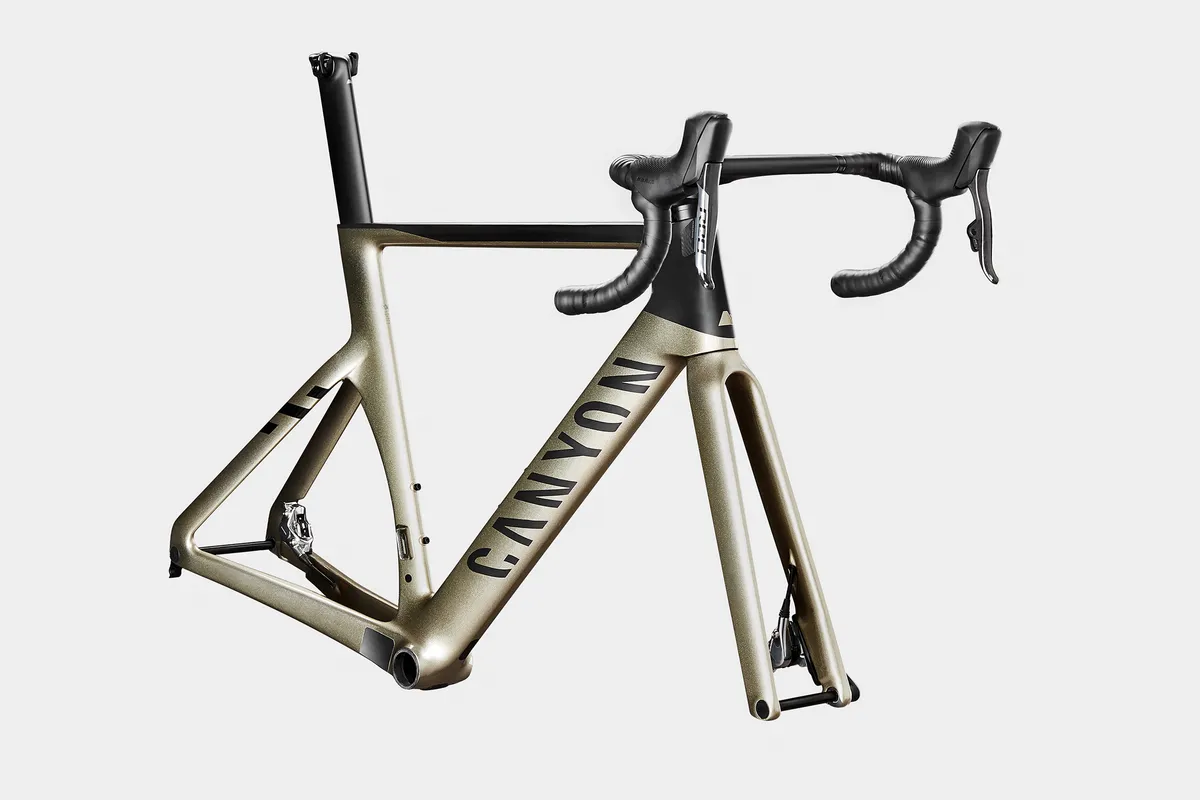
The Aeroad CFR frameset comes with SRAM Red eTap AXS brakes, hydraulic hoses and shifters pre-installed.
Canyon says this is so no additional cable-routing is required by the customer. At the time of launch, there's no Shimano Di2 or Campagnolo EPS frameset option, but the frameset is compatible with those groupsets.
- Frame: Canyon CFR
- Fork: Canyon FK0060
- Handlebar: Canyon CP0018 Aerocockpit
- Colours: Stealth, tinted chrome
- Sizes: 2XS, XS, S, M, L, XL, 2XL
- Weight (claimed): 2.95kg
- Price: £4,449 / €4,299 / $4,349 / AU$6,749
Canyon Aeroad CF SLX AXS
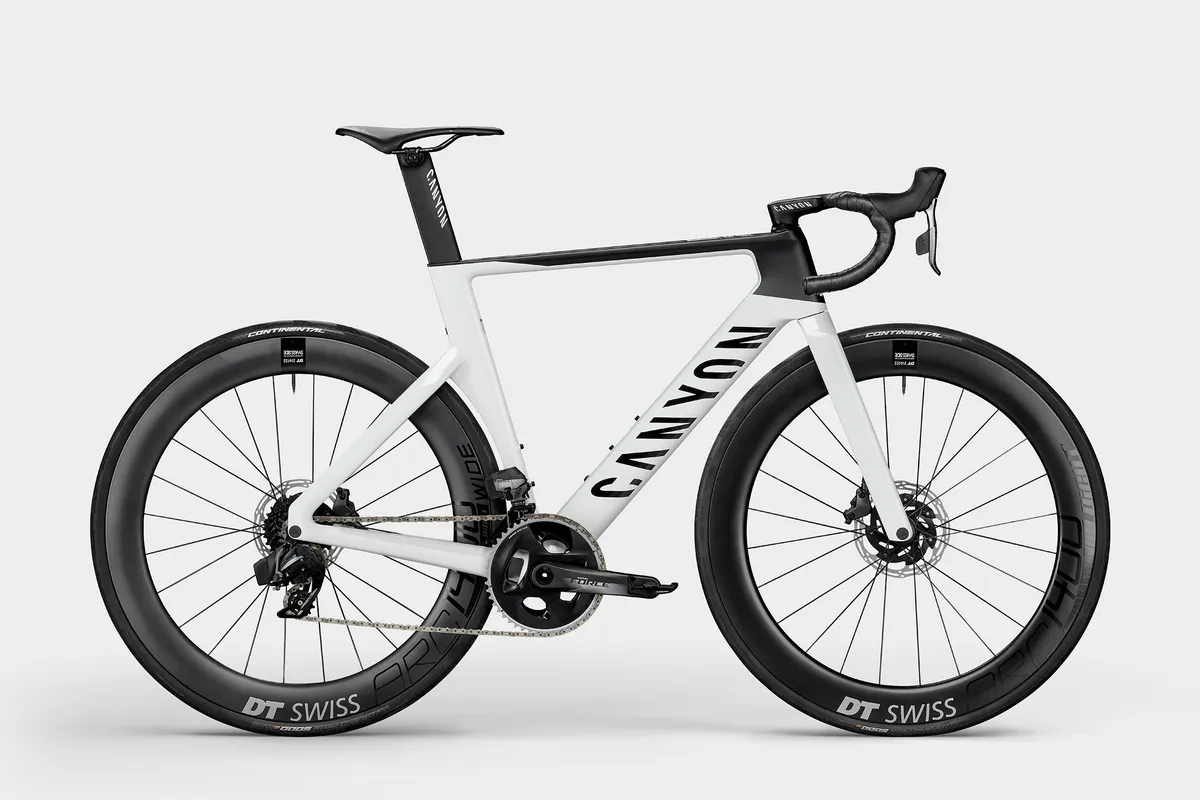
- Frame: Canyon CF SLX
- Fork: Canyon FK0060
- Handlebar: Canyon CP0018 Aerocockpit
- Groupset: SRAM Force eTap AXS
- Wheels: DT Swiss ARC 1400 Dicut 62 DB
- Colours: Stealth, pro white
- Sizes: 2XS, XS, S, M, L, XL, 2XL
- Weight (claimed): 7.73kg
- Price: £5,499 / €5,299 / $5,349 / AU$8,299
Canyon Aeroad CF SLX Di2
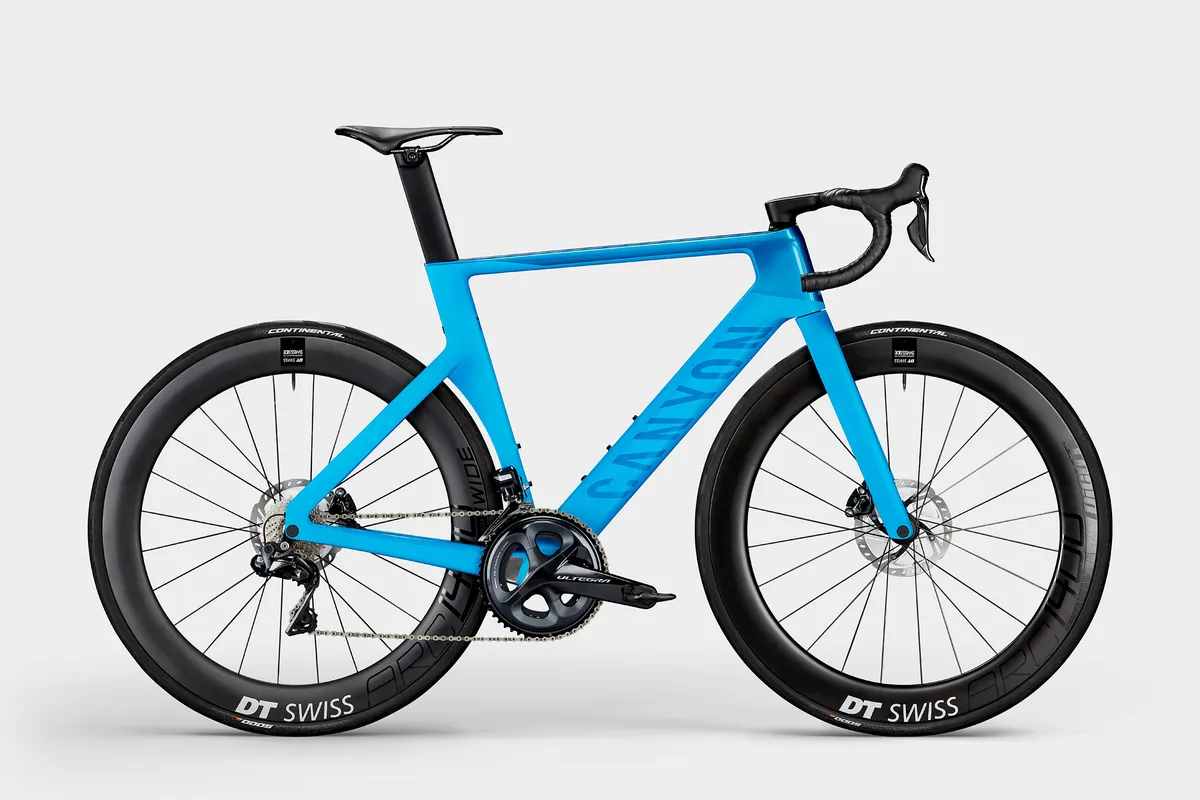
- Frame: Canyon CF SLX
- Fork: Canyon FK0060
- Handlebar: Canyon CP0018 Aerocockpit
- Groupset: Shimano Ultegra R8170 Di2
- Wheels: DT Swiss ARC 1400 Dicut 62 DB
- Colours: Stealth, pro white, blue in blue
- Sizes: 2XS, XS, S, M, L, XL, 2XL
- Weight (claimed): 7.57kg
- Price: £5,199 / €4,499 / $5,049 / AU$7,849
Canyon Aeroad CF SL 8
- Frame: Canyon CF SL
- Fork: Canyon FK0099 (700c), FK0100 (650b)
- Handlebar: Canyon CP10 Aerocockpit
- Groupset: Shimano Ultegra R8000
- Wheels: Reynolds AR 58/62 DB
- Colours: Stealth, off blue
- Sizes: 3XS (650b), 2XS (650b), XS, S, M, L, XL, 2XL
- Weight (claimed): 7.78kg
- Price: £3,799 / €3,699 / $3,749 (not available in the US at launch) / AU$5,799
Canyon Aeroad CF SL 8 WMN
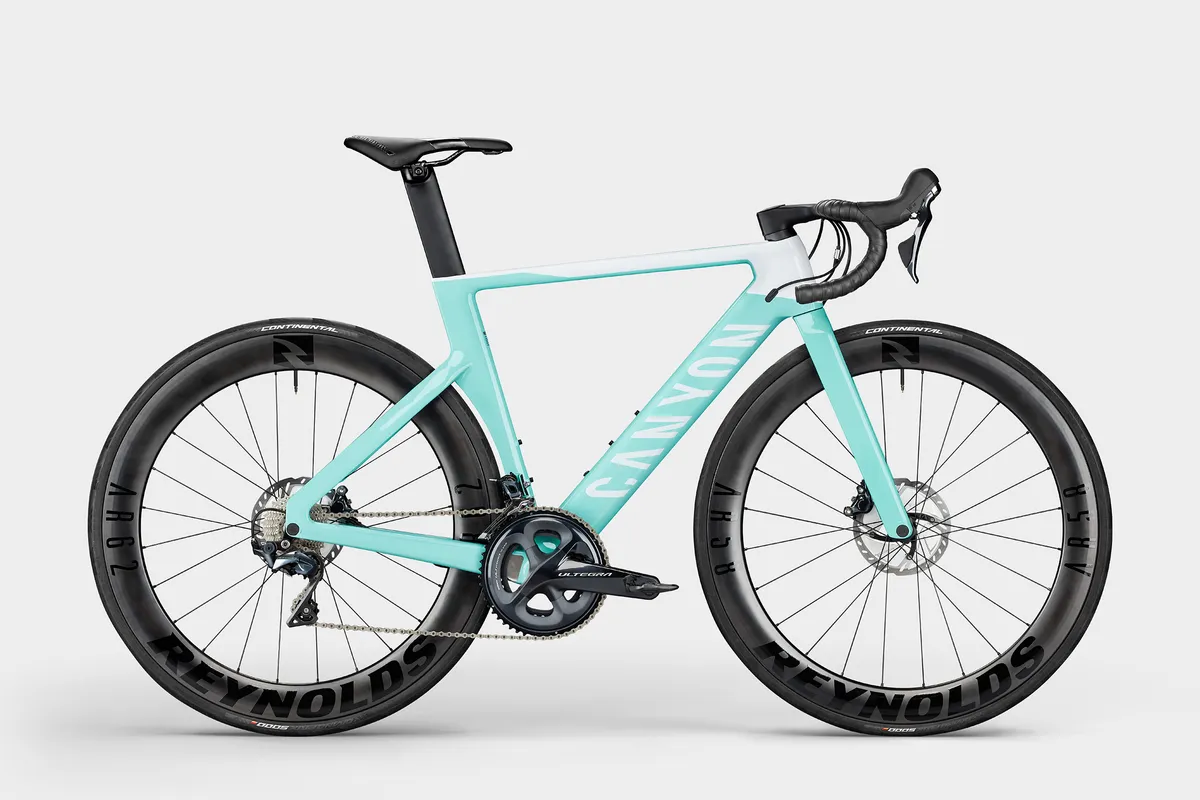
- Frame: Canyon CF SL
- Fork: Canyon FK0099 (700c), FK0100 (650b)
- Handlebar: Canyon CP10 Aerocockpit
- Groupset: Shimano Ultegra R8000
- Wheels: Reynolds AR 58/62 DB
- Colours: Non mint
- Sizes: 3XS (650b), 2XS (650b), XS, S, M, L, XL, 2XL
- Weight (claimed): 7.78kg
- Price: £3,799 / €3,699 / $3,749 (not available in the US at launch) / AU$5,799
Canyon Aeroad CF SL 7
- Frame: Canyon CF SL
- Fork: Canyon FK0099 (700c), FK0100 (650b)
- Handlebar: Canyon CP10 Aerocockpit
- Groupset: Shimano 105 R7000
- Wheels: Reynolds AR 58/62 DB
- Colours: Stealth, racing red
- Sizes: 3XS (650b), 2XS (650b), XS, S, M, L, XL, 2XL
- Weight (claimed): 7.78kg
- Price: £3,399 / €3,299 / $3,349 / AU$5,149
